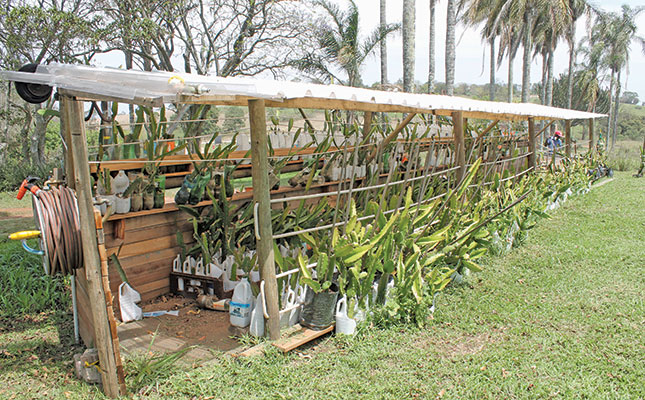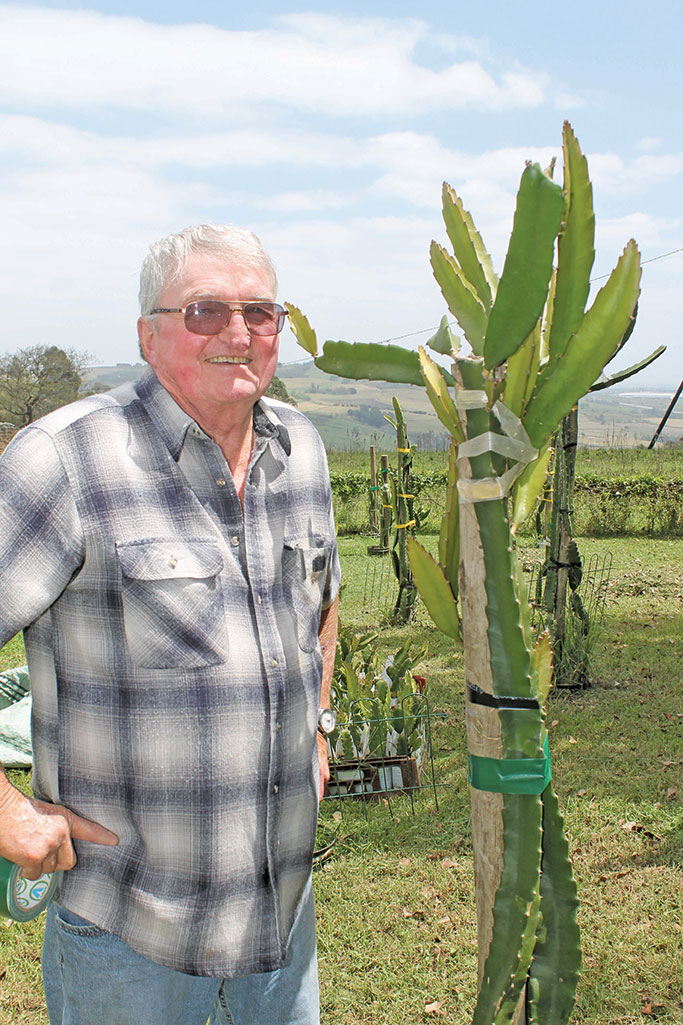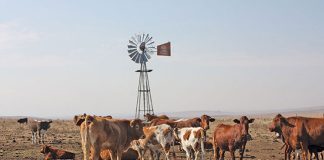
Photo: Lloyd Phillips
Although he has long owned and operated a wood-turning business on his 1,5ha smallholding in KwaZulu-Natal’s Drummond area, Frikkie Adams has also spent years looking for an interesting, “but low-maintenance”, crop to experiment with as a hobby in his semi-retirement.
In May last year, Adams saw some strange-looking grapefruit-sized fruit for sale at his local Spar. They were dragon fruit, and he was so interested to learn more that he happily paid R19,50 for just one fruit for further investigation.
At home, he peeled the purple outer skin and ate the white flesh, which was full of tiny black seeds.

“It had a very unusual flavour that I still find difficult to describe,” explains Adams. “The texture was like a soft apple or a watermelon. It was also very juicy, and I was amazed at how much edible flesh there was. I went back to Spar and bought 15 more!”
Adams was convinced that he had finally found the crop he was looking for, and spent hours on the Internet researching whatever information he could find on dragon fruit and its production.
He learnt that the purple- or pink-skinned, white-fleshed dragon fruit he had bought from Spar was Hylocereus undatus, one of three species of the fruit. There are also the red-skinned, red-fleshed variety, H. costaricensis, the yellow-skinned, white-fleshed H. megalanthus and a number of dragon fruit hybrids.
Essential minerals
According to healthline.com, dragon fruit are “low in calories but packed with essential vitamins and minerals”.
They also contain a substantial quantity of dietary fibre.
More specifically, according to the website, a 227g-serving of dragon fruit contains 136 calories, 3g protein, 0g fat, 29g carbohydrates, 7g fibre, 8% of a person’s recommended daily intake (RDI) of iron, 18% RDI of magnesium, 9% RDI of vitamin C, and 4% RDI of vitamin E.
Dragon fruit also provides beneficial compounds such as polyphenols, carotenoids and betacyanins.
“After I’d done my initial research, in August last year I started out with 200 plant cuttings of the red-skinned, red-fleshed variety I’d bought from a grower in North West,” says Adams.
“Each cutting was about 400mm long. I then had 14 days to get them planted, otherwise they’d start losing their growth quality.”
Adams initially tried planting some of the cuttings in conventional black plant bags, but
gave this up after discovering that the tops of the bags folded over from the force of the water when he irrigated the cuttings with a hose.
He decided to try 2ℓ plastic soft drink bottles as planting containers. He cut off and discarded the sloping tops, and cut out a hole near the top of each bottle so that the bottle could be carried easily by hand. He also cut two drainage slits into the bottom of each bottle.
All seemed fine, until he and his team discovered that the modified plastic bottles became top-heavy and regularly fell over.
For the third time, Adams began looking for a solution, and finally hit on exactly the right thing: square-based, 2ℓ plastic milk bottles. Adams and his staff then had to source and modify hundreds of these and replant as many cuttings as possible.
He laughingly points out it’s important to ensure that dragon fruit cuttings are planted the right way round, with the small thorns facing upwards, or the cuttings might start growing roots into the air instead of into the growing medium.
Growing medium
“For my growing medium, I use a mixture of bought-in compost, river sand and soil (one-third each) from my smallholding,” says Adams.
“I fill about half of each bottle with the growing medium and insert a single cutting into each bottle. I then give each cutting a good first irrigation until water just starts to run out the drainage slits.”
While Internet literature states that dragon fruit plants do not require much water, Adams has found that frequent irrigation with small volumes of water are necessary, especially in hot weather.
Dragon fruit plants do not readily show when they are water-stressed, he adds. As a reminder to himself to irrigate, Adams has cleverly planted a few African wild potato plants (Hypoxis hemerocallidea) between his hundreds of dragon fruit plants to act as ‘signallers’ for when irrigation is needed. If he sees the potato plants wilting, he knows that they and the dragon fruit plants need water.
Propagating
“I’ve discovered that it takes eight to 10 weeks for my dragon fruit cuttings to start putting down roots, so I’ve had to learn to be patient with them,” says Adams.
“Fairly soon thereafter they’ll start putting out new stem growth starting from the top of each cutting.
“For the first six months that I propagated my cuttings, I did so only outdoors. But I noticed that their growth wasn’t as vigorous as the literature said it should be. I put this down to the cooler night-time outdoor temperatures in my area.”
Adams solved this problem by converting an unused outbuilding on his smallholding into a simple 36m² greenhouse. This can hold about 800 modified plastic bottles and their cuttings.
To allow plenty of sunlight in for photosynthesis and for heating the greenhouse, he cut sections of translucent polycarbonate sheeting and fitted these to parts of the roof and as windows along the sides of the building.
After this, Adams experienced few major temperature variations between day and night, and his cuttings in the greenhouse began growing noticeably faster.
Since August 2019, he has multiplied his original 200 dragon fruit plant cuttings to almost 1 500 cuttings and more mature plants.
Every home should have one
Adams would like to see every household grow at least one dragon fruit plant (provided the climate is suitable), so that the nutritious fruit can help improve food security.
“A dragon fruit plant doesn’t need much space to grow, but it does have a weak stem, so it needs to be tied to some form of vertical support such as a pole or trellis,” says Adams.
“When the plant is mature enough to start fruiting, it forms a canopy, like the ribs of an umbrella; this also needs support, especially when the canopy starts fruiting.”
Proper care includes sufficient watering and applying two handfuls of nutrient-rich compost and a tablespoon of 2:3:4 fertiliser around the base of the plant every one to two months.
Adams adds that a “conventional root-and-shoot” can take between one and two years to produce its first crop of fruit after being transplanted, so a grower needs to be patient.
He is, however, experimenting with longer lengths of dragon fruit cuttings to test whether this period can be reduced.
Interestingly, dragon fruit plants flower only between sunset and sunrise, and produce magnificent blooms that can be up to 30cm in diameter. The individual fruit can weigh as much as 600g.
“I really believe that because of its nutritional value and size, dragon fruit should be considered as ‘dragon food’, especially for food-insecure households,” says Adams.
Email Frikkie Adams at [email protected].










